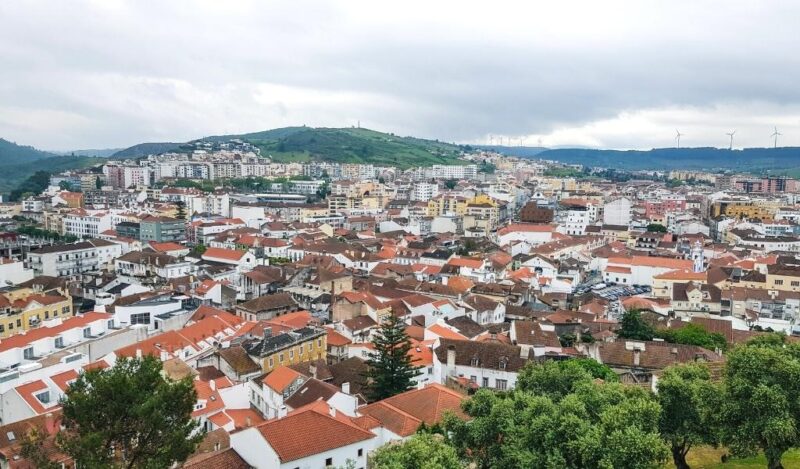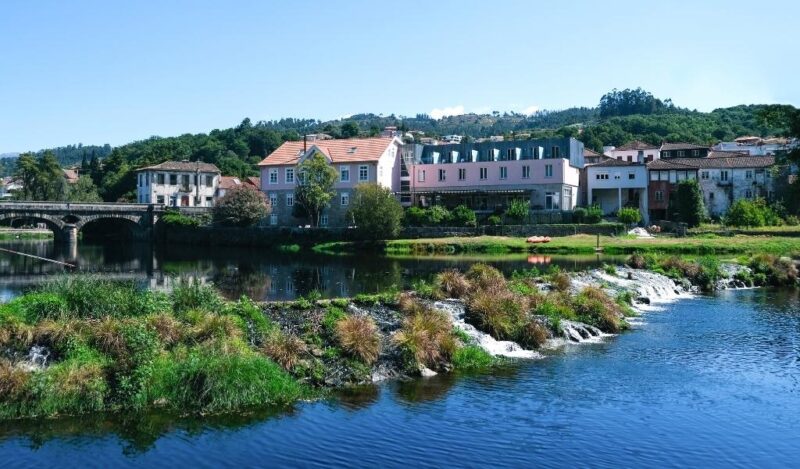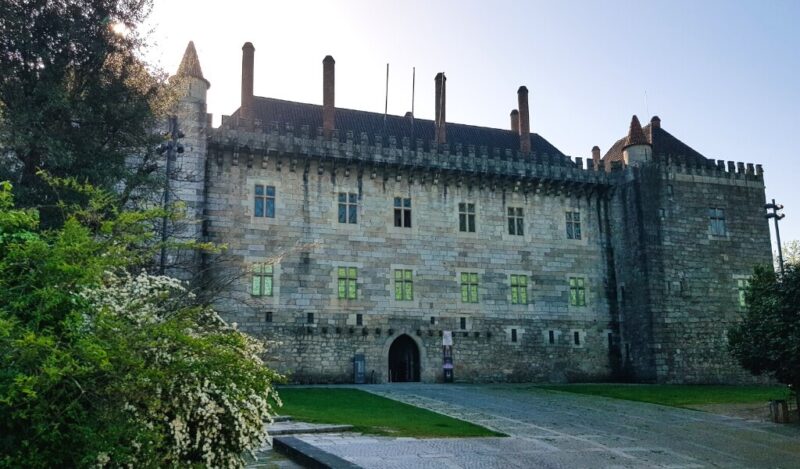Do you know the medieval town of Provins? Although it has been a UNESCO World Heritage Site since 2001, I confess that I only found out about this “very well kept secret” of Paris, when I moved to France in 2018!
An hour from the French capital, Provins is proud of being a surprisingly well-preserved town since the Middle Ages, with almost sixty local monuments classified historically!
So, do you want to know more about 1 Day In Provins: The Perfect Provins Itinerary? Keep reading!
This post may contain affiliate links, meaning I earn a small commission if you make a purchase, at no additional cost to you. Please read my disclosure & privacy policy for more information.
No time to read now? Pin it for later!


Brief History of Provins
At first, the town of Provins became a European reference during the Middle Ages, with the famous Foires de Champagne, promoted by the homonymous county. These fairs were immensely successful during the 12th and 13th centuries because the historic province of Champagne – where Provins was located – benefited from an excellent geographical location.
The proximity of economically active regions such as Flanders, Germanic territories, and Mediterranean countries, allowed the promotion of trade in that area of Europe. At that time, Provins began to be visited throughout the year by cloth traders from Flanders, financials from Lombardy, and even spice traders from the East!

The Champagne Fairs were deactivated at the beginning of the Hundred Years’ War (1337-1453), at a time when shipping routes began to replace mercantile operations in Europe. Therefore, in the middle of the 14th century and with the war unleashed, the regions of Champagne and Brie were added to the Kingdom of France. As a result, trade routes changed and Provins‘ decline began to be felt drastically.
A few centuries later, the medieval town was unexpectedly sought after again, this time by names like the writers Jules Vernes and Honoré de Balzac or the painter Moreau le Jeune. These nineteenth-century artists arrived attracted, above all, by the romantic landscape of the ruins of the walls and the Cesar Tower, in the upper part of Provins.
World Heritage
Did you know that Provins, Town of Medieval Fairs was part of France’s fifteenth set of inscriptions on the UNESCO World Heritage List? This 25th session of the World Heritage Committee took place in Helsinki (Finland), between December 11th and 16th, 2001.
Nowadays, France is the third country in the world and the second country in Europe with the most UNESCO sites, tied with Germany. It has fifty-two heritage assets (both cultural and natural) inscribed on the world list of the United Nations Educational, Scientific, and Cultural Organization!
In the meantime, I’ve already had the opportunity to visit nine of them:
- Castle of Sully-sur-Loire (2000)
- Historic Center of Avignon: Papal Palace, Episcopal Ensemble and Avignon Bridge (1995)
- Le Havre, the City Rebuilt by Auguste Perret (2005)
- Mont Saint-Michel and its Bay (1979)
- Nice, Winter Resort Town of the Riviera (2021)
- Palace and Park of Fontainebleau (1981)
- Palace and Park of Versailles (1985)
- Paris, Banks of the Seine (1991)
- Provins, Town of Medieval Fairs (2001)
Visiting Provins
If you’re looking for an excellent daily program outside the French capital, then you really have to visit the medieval town of Provins!
All you have to do is board the Transilien P train at Gare de l’Est and proceed to Provins (zone 5), the terminal station on the railway line. Tickets cost €11.35 (adults) and €5.65 (children) and can be purchased at any station. So, ask at ticket offices or look at vending machines for the Billet Île-de-France.
In my case, since I left from Gare de Marne-la-Vallée – Chessy, all I had to do was take bus number 50, which also goes to the medieval city. By bus, you take the trip in about 75 minutes and get off directly at the Haute Ville, near the walls.
Practical Information
To visit the town, I recommend purchasing the Pass Provins at the Tourist Office. Basically, this pass is a single fare ticket at a reduced price, which allows you to visit the four main monuments in Provins:
- Grange aux dîmes
- Musée de Provins et du Provinois
- Souterrains
- Tour César
In addition, the Pass Provins includes other additional benefits, such as preferential rates for other places of interest, individual guided tours, and even historical shows. Unfortunately, the latter did not apply in my case, since I went during the low season.
The Pass Provins can be purchased for €11 (over 13 years old) or for €7.50 (children from 4 to 12 years old), through the online ticket office of the Medieval Town of Provins. There’s also a Pass Famille available for €34.50, for two adults and two children.
WARNING: The Pass Provins can’t be purchased within 24 hours of the visit! If so, you can get it for €12 at the Tourist Office of Provins or at any of the monuments mentioned above (except at the museum).
Provins Itinerary
Remparts
The walls of Provins were built in the 13th century and, at that time, encircled the entire town on an extension of five kilometers! Built around a plateau, Provins quickly gained a structure based on two urban centers: Ville Haute and Ville Basse, nicknamed Châtel and Val, respectively.

The walls of Provins were built in the 13th century and, at that time, encircled the entire town on an extension of five kilometers! Built around a plateau, Provins quickly gained a structure based on two urban centers: Ville Haute and Ville Basse, nicknamed Châtel and Val, respectively.
Porte Saint-Jean
Saint John’s Gate was the first monument I saw, after getting off the bus and passing by the Tourist Office. To the right of the Porte Saint-Jean, stands the place where historical shows are held during the medieval fair, such as “Epées et Donjon” or “La Légende des Chevaliers”.

At that time, this basilar entrance to Provins ensured the defense of the old Route de Pa
ris, the main road that connected the most important cities to the French capital!
Porte du Jouy
Recently restored, the Jouy Gate was established in the 13th century. In the center, there was a small bell tower, to watch the enemy and, above all, alert in case of danger.

Take the opportunity to climb the walls and observe the magnificent panoramic view that surrounds the citadel. From there, it’s already possible to see some emblematic monuments of Provins, such as the Tour César and the Collégiale de Saint-Quiriace.
Place du Châtel
This square is the heart of the Ville Haute, adorned with an old well and the so-called Croix des Changes, which dates from the 13th century. The Exchange Cross was also called Croix aux Édits, since it was here that not only monetary transactions were made, but also the county’s editorials.

Around the central square, there are stores of merchants and artisans selling local products and souvenirs. Among the most popular are, for example, handmade soap and candles, medieval cookies, period clothing, wooden toys, and others. So be sure to visit the Maison aux 4 Pignons or the Maison du Terroir et de l’Artisanat.
Tour César
Installed at the end of a large rocky platform, the Caesar Tower protected the old palace of the counts of Champagne and dominated the valley, as a symbol of the county’s power and sovereignty. Constructed in the 12th century, it has had numerous functions: watchtower, prison, and steeple.
Interestingly, the tower had no proper name until the 17th century, in such way that it was called the “Great Tower”, “Tower of the Shire” or “Tower of the King”. In fact, the name “Caesar” only evokes a willingness to compare the tower’s origins with Ancient Rome and not the possibility that Julius Caesar passed through Provins.

Today, the Tour César is the symbol of Provins, at the same time that it’s one of the most significant testimonies of medieval military architecture. So, take the opportunity to enjoy the privileged and stunning view over the town and its surroundings, which the top floor offers!
The Caesar Tower is open during the week from 2 pm to 5 pm and on weekends and holidays from 11 am to 5 pm. During the festival “Noël à Provins” (in December), you can visit it from 11 am to 6 pm. However, the monument closes on January 1st and December 25th. The single ticket costs €4.30 (adult) and €2.80 (child), but I recommend purchasing the Pass Provins or Pass Famille.
Collégiale Saint-Quiriace
This monumental work was built in the 12th century, at the behest of Henry I, Count of Champagne. The main initial objective was to extend the nave to the end of the square, but due to financial difficulties during the reign of Philip IV, the church was never finished.

Its towering dome – easily seen from any point of Provins – was only built in the 17th century, after the collapse of part of the building. Despite its rocky fate since the 14th century, the Saint-Quiriace Collegiate Church remains imposing and is freely accessible.
Musée de Provins et du Provinois
First of all, the Provins and Provinois Museum is installed in the so-called Maison Romane. This house has existed since the 12th century and is probably the oldest civil building in town! Located in the Jewish quarter, it’s thought that it may even have served as a synagogue for the local community.
The museum’s theme – as the name implies – is directly related to the history of the medieval town and its inhabitants. The collection also includes artifacts from the surroundings of Provins donated by former owners, from the Antiquity to the 19th century.

The Musée de Provins et du Provinois is open on weekends, holidays and school breaks from 2 pm to 5:30 pm. During the week, hours vary between 11 am-12 pm to 5:30 pm-6:30 pm. On the other hand, on “Nuit européene des Musées” (May 16th), you can visit it from 6 pm to 12 am. Nonetheless, the monument closes on January 1st and December 25th. The single ticket costs €4 (adult) and €2 (child), but I recommend buying the Pass Provins or Pass Famille.
Grange aux Dîmes
The Tithes’ Barn is a typical Provins house, with a large lower room with vaulted ceilings. However, this denomination did not appear until the 16th century, when the tithes (taxes paid to the Church) started to be stored here.
During the Foires de Champagne, the building was rented by merchants from other regions and it’s known, for example, that Toulouse merchants were its tenants in 1223. At that time, the three-story house was used for also three distinct functions: the salle basse (basement) – served as a storehouse for goods, the ground floor as a store, and the first floor was for housing.

The Grange aux Dîmes is open during the week from 10 am to 6 pm and on weekends, holidays, and school holidays from 2 pm to 5 pm. During the festival “Noël à Provins”, the schedule operates from 11 am to 5 pm. However, the monument closes on January 1st and December 25th. The single ticket costs €4.30 (adult) and €2.80 (child), but I recommend purchasing the Pass Provins or Pass Famille.
Souterrains
From a guided tour of no more than 25 people, it’s possible to glimpse a small sample of an admirable network of underground tunnels at the Basse Ville. The undergrounds have centuries of history and have taken on different functions, such as paths, warehouses, shelters, and even secret meeting spaces!
Even though it’s not possible to explore the second network of tunnels that exists in the Haute Ville, as it’s privately owned, the tour guide explained in detail what is undoubtedly one of the most mysterious places of Provins.

In the low season, the Souterrains have visits at 2:30 pm, 3:30 pm, and 4:30 pm on weekends, holidays, and school holidays. As for the high season, the hours extend from 10:30 am to 5:30 pm, although during the week it only operates in the afternoon. The monument closes on January 1st and December 25th and the single ticket costs €4.50 (adult) and €3 (child), but I recommend getting the Pass Provins or Pass Famille.
If you want to take advantage of a special occasion to visit the Undergrounds, I recommend some themed days or festivals in Provins. You have “Les Médiévales de Provins” (in June), with opening hours from 10:30 am to 4:00 pm, the themed night tour of “Lueurs du Temps” (in summer) and “Noël à Provins”, from 10:30 am at 5 pm.
Église Sainte-Croix
Completed in the 12th century, in the place where there was an old chapel, the Church of the Holy Cross owes its current name to the Cross of Christ. This is because the legend goes that Theobald V, Count of Blois brought a piece of the famous Croix du Christ to this place!

After a tragic fire in 1305, the church was rebuilt during the 16th and 17th centuries. That is how it ended up inheriting its central Renaissance façade.
Église Saint-Ayoul
Previously, in the center of the Basse Ville, the churchyard of the Church of Saint Ayoul was the main place for trade fairs in Provins. However, the entrance gate started to be altered in the 11th century. And today, it’s adorned with bronze statues, thanks to a recovery carried out by the sculptor Georges Jeanclos, in 1986.

Meanwhile, the Église Saint-Ayoul has recently reopened after a major restoration intervention. Just to illustrate, floors, walls, arches, roofs, stained glass, and lighting are some of the elements that have not been renovated since the 16th century!
Tour Notre-Dame-du-Val
The Tower of Notre Dame of the Valley, in the middle of the historic center of the Basse Ville, was also recently renovated. The religious monument is so well hidden that I almost missed it!
Although it was built in the 16th century, it’s the last vestige of a church and a cloister with the same name.

Unfortunately, no other part of this temple has survived the massive destruction of the French Revolution.
In addition, the bells you can see in the belfry come from the nearby Church of Saint Ayoul.
Durteint et Voulzie
In the Middle Ages, Provins‘ great artisan specialty was cloth.
Made of wool, the fabrics were famous for their quality and the characteristic color, a very dark blue obtained due to the consistency of the water of a small watercourse called Durteint.

Over the years, the water became indispensable for the work of several professions, such as fur tanners, butchers, and, of course, washerwomen.
At present, both the Durteint and the Voulzie River offer picturesque views and are an excellent visit, before finishing the walk at the railway and road station.
Map of the Provins Itinerary
Share this blog post on your social media!
More Posts about France
Gustave Moreau Museum: Best Tips For Visiting In 2024
Museum Of Romantic Life: Best Tips For Visiting In 2024
Marmottan Monet Museum: Best Tips For Visiting In 2024
More Posts about Travel Itineraries
1 Day In Penafiel: The Perfect Penafiel Itinerary
1 Day In Torres Vedras: The Perfect Torres Vedras Itinerary
2 Days In Arcos De Valdevez: The Perfect Arcos De Valdevez Itinerary
More Posts about World Heritage
Palace Of The Dukes Of Braganza: Best Tips For Visiting In 2024
World Heritage In Castile And León (2024)
Machado De Castro National Museum: Best Tips For Visiting In 2024
What Photography Gear Do I Use?
- Camera Body: Fujifilm X-T4 Mirrorless
- Camera Lens: Fujinon XF 18-55 mm F2.8-4 R LM OIS
- Tripod: Manfrotto Compact Action
- Small Tripod: Manfrotto PIXI Mini
- Smartphone Adaptor: Manfrotto PIXI Clamp
- Memory Card: SanDisk 128GB Extreme PRO SDXC










Hi there!
Can you recommend any lunch restaurants in Provins? Family of four traveling late March. Thank you!
Hi! I would say La Croix d’Or, L’Essentiel, A La P’tite Savoie, or L’Inattendu. They’re all family-friendly and offer great French food!
Did you find many sites were closed in the low season? I am visiting in November and am worried things will not be open.
I went to Provins in the low season (February 2020) and everything was open. That includes museums, churches, restaurants, and souvenir shops – which are the places that usually close in winter.
However, I recommend checking out the tourism board’s website – provins(dot)net – as close to your visit day as possible! 🙂